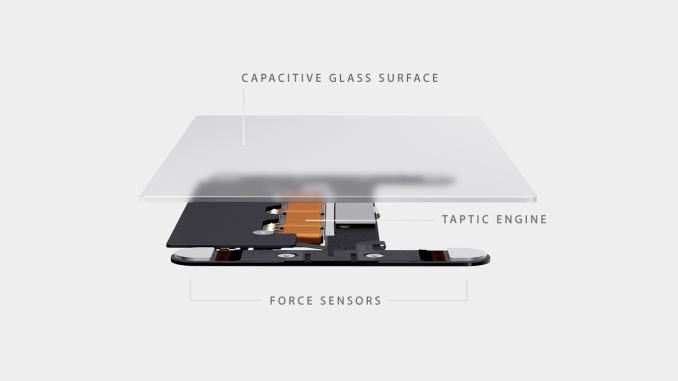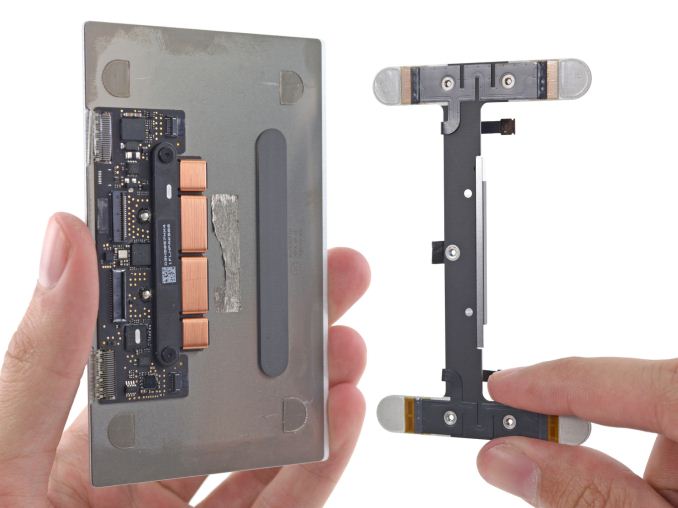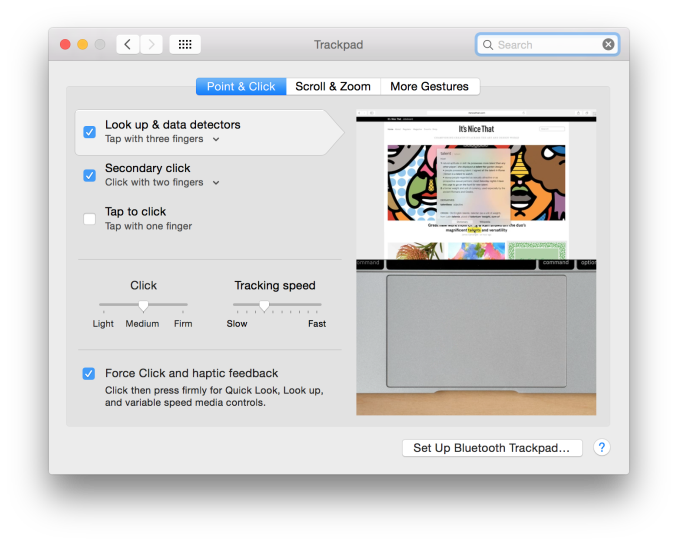The 2015 MacBook Review
by Ryan Smith on April 14, 2015 10:15 AM ESTForce Touch Trackpad
Along with Apple’s changes to their keyboard, the company has also gone in and significantly reworked their trackpad. The new Force Touch Trackpad represents the biggest change to Apple’s trackpad design since the creation of the capacitive, multi-touch pivoting trackpad introduced on the unibody MacBook Pro. In putting together the Force Touch Trackpad, Apple has significantly reworked the internals of the trackpad, creating a trackpad that behaves a lot like their traditional trackpad with some new features, but under the hood relies on some very different mechanisms.
The big change here is that Apple has done away with the traditional pivot and switch mechanism. With pivot and switch, the capacitive trackpad surface would act like a small touchscreen, and underneath it was a switch to register when the trackpad was pressed down. Mechanically the trackpad pivoted from the top (Apple likes to compare it to a diving board), with the trackpad inferring what action to take based on the combination of the capacitive readings and the switch reading. Multi-finger gestures would rely solely on the capacitive layer, primary/secondary clicks would be based on the number of fingers in use when the switch was actuated, etc.
The Force Touch Trackpad on the other hand eliminates the pivot and switch mechanism in favor of a combination of an electromagnet and force/pressure sensors. The pressure sensors essentially replace the physical switch, allowing the trackpad to tell when it has been pressed based on the amount of pressure, and thanks to the pressure sensors it can now tell how hard it has been pressed as opposed to the binary nature of the physical switch. Meanwhile without a physical switch in place to provide the clicking sensation and feedback of pressing down on the touchpad, Apple’s electromagnet – the Taptic Engine – activates to simulate the feeling and noise of pressing a switch.
Update 04/15/2015: iFixit has a great shot of the trackpad's internals, including a good look at just how big the electromagnet/taptic engine really is.
The end result is that the MacBook’s trackpad is among the first wave of devices that ships with Apple’s next generation trackpad and the enhanced capabilities that go with it. Ignoring the pressure sensitivity for a moment (we’ll get back to it), replacing the pivot and switch for an electromagnet works shockingly well. From a touch & feel standpoint the Force Touch Trackpad feels virtually identical to a traditional trackpad, to the point where it’s more than a bit uncanny. In practice you are not actually triggering a switch nor is the trackpad really moving (technically it’s deforming ever so slightly), but it sure feels like you’re working a switch. Apple has clearly done their homework on getting an electromagnet to emulate a switch, to great results. Meanwhile they don’t have the trackpad’s acoustics precisely matching a switch, but the resulting pinball-machine like plunk is close enough to a click that I don’t imagine anyone will mind the difference.
One side benefit of this change is that the trackpad feels the same throughout, and unlike the pivoting trackpad does not require more or less force depending on where you are relative to the pivot point. The variable force required has never been a major problem in my experience, but it is nice to no longer need to worry about where your fingers are relative to the top, and consequently how much force you need to use.
However the bigger deal is that by making the amount of force required to click consistent throughout the entire trackpad, Apple can now use the amount of pressure applied as another input, making the trackpad pressure-sensitive. The underlying pressure sensors and electromagnet are by default programmed to have two levels of feedback – a shallower press is equivalent to a click – and a deeper press brings about the pressure-sensitive “Force Click.” What force clicking does depends on the application, and right now it’s clear that Apple is still experimenting with what they can do with pressure sensitivity. The most obvious uses include line thickness in drawing applications, but the company is also using it for things such as variable speed fast forward and rewinding in QuickTime/iMovie. At times the force click is treated like a 3rd (tertiary) click, and other times the result is based on variable pressure. Since this is a new (and uncommon) feature there’s no global action assigned to the force click – nor does it behave as a middle click on a regular mouse – so what happens is up to the application.
In implementing force click and the Force Touch Trackpad, Apple does offer the ability to control the amount of pressure required and whether force click is active. With force click deactivated the trackpad behaves more or less identical to a traditional trackpad with a single click level. Meanwhile the click pressure setting is interesting, though I’m not entirely convinced it’s all that effective. Short of the tools to actually measure click pressure, I’m not so sure Apple is changing the amount of pressure required to trigger a click so much as they’re changing how hard the electromagnet vibrates. The feedback change is certainly very subtle going from light to firm, and if there is a change in the amount of pressure required then it is certainly equally subtle.
Ultimately whether the Force Touch Trackpad is a major upgrade or not is going to depend on a user’s ability to make use of the force click features. Even turned off, the new trackpad is essentially an improved version of the old trackpad without the minor drawbacks of the pivot mechanism. But with the force click turned on, then it brings new (though not always useful) actions to the trackpad that in turn makes it a bigger upgrade over the old trackpad.
In any case, the MacBook along with the 2015 MacBook Pro 13” are the first wave of devices to implement the new Force Touch Trackpad. Given its expanded capabilities I would expect Apple to eventually replace many (if not all) of their trackpads with this new design. Certainly the 15” MacBook Pro is a likely candidate, as is a future version of the Magic Trackpad. What remains to be seen is whether the next MacBook Air also gets this new trackpad, or if Apple withholds it to keep the products differentiated and to keep the costs of the MacBook Air down.














354 Comments
View All Comments
ws3 - Tuesday, April 14, 2015 - link
Charge when you aren't using any external device, don't charge when you are. Charge overnight every night.I understand that this pattern doesn't fit everyone's needs but this product is not meant for people who truly require multiple things plugged in at a time that is obvious. If you are such a person, buy a different product.
People who don't need to plug in multiple things at the same time and people who only think they need to plug in multiple things at the same time may be well served by this product.
As for Jobs, this product is exactly what he dreamed of. He hated fans and he hated ports. He'd probably like it even better if it had zero ports.
repoman27 - Tuesday, April 14, 2015 - link
Aside from implementing a lot of brand new specs, this is just a standard USB charging port though. Get a USB hub that supports BC 2.0 passthrough from Monoprice or whoever in a month or two and you're all set. A simple y-adapter cable that allows power in for charging and DisplayPort out could probably be sold for $15.These are easily solvable problems.
repoman27 - Tuesday, April 14, 2015 - link
Sorry meant PD, not BC.darwinosx - Tuesday, April 14, 2015 - link
There are already cables that allow this.nyoungman - Tuesday, April 14, 2015 - link
When the MacBook Air was first introduced it only had one USB port. Now it has two.It will be curious to see how this develops in the next iteration or two, esp. since Apple acquired Beats, and they make wireless headphones.
joscha - Tuesday, April 14, 2015 - link
Why do you keep insisting that this is somehow a tablet? Apple had a 12in laptop ten years ago. This thing has no A7 processor, no iOS, no touch screen. Standard sized keyboard, touchpad, OS X.This is just a normal Macbook with big dongles, aimed at early adopters that can live with slightly limited memory, harddisk and speed.
Klug4Pres - Tuesday, April 14, 2015 - link
I agree. I fail to see the likeness of this device to a tablet.ws3 - Tuesday, April 14, 2015 - link
It's like a tablet in that it has a single port, low power processor with passive cooling, and has adopted the iPad color scheme. Ryan didn't claim anything more that that.TEAMSWITCHER - Tuesday, April 14, 2015 - link
It's also thin, light, and easily carried. I switched to an 11" MacBook Air with a Brenthaven sleeve. When people see it, they assume it's an iPad. Until I take it out and *SURPRISE* it's a MacBook. I imagine this new MacBook will generate an even bigger reaction.Alexey291 - Thursday, April 30, 2015 - link
"Surpise its macbook" more like surprise its a tablet without a touchscreen xD